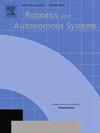Inspection robot GPS outages localization based on error Kalman filter and deep learning
IF 4.3
2区 计算机科学
Q1 AUTOMATION & CONTROL SYSTEMS
引用次数: 0
Abstract
In urban environments, inspection robots face complex terrain and variable motion states, posing high demands on their positioning systems. Although the integration of Micro-Electro-Mechanical Systems Inertial Navigation Systems (MEMS-INS) with the Global Positioning System (GPS) provides continuous positioning information, high buildings and tunnels in cities can block GPS signals, leading to signal interruptions and increased positioning errors. During GPS outages, MEMS-INS gradually accumulates errors, severely affecting positioning accuracy. To address this issue, this paper proposes an adaptive error state Kalman Filter (AESKF), which employs an adaptive mechanism to eliminate the noise impact of MEMS-INS and reduce reliance on the process model. Additionally, a deep learning framework based on the Self-Attention mechanism of the Transformer and a custom loss function Long Short-Term Memory (LSTM) module is proposed to predict position increments of the inspection robot. Combining AESKF with Transformer-LSTM achieves optimized positioning accuracy of the inspection robot during GPS outages in dynamic urban environments. Simulation and practical experimental results demonstrate that the combination of AESKF and Transformer-LSTM significantly improves positioning accuracy. Compared to other mature methods, the Root Mean Square Error (RMSE) of positioning is reduced by up to 83.64 % in the north direction and 89.56 % in the east direction. When the GPS signal interruption lasts for 10 s and 60 s, the maximum position error standard deviation (STD) is 0.1186 m and 1.0417 m, respectively.
基于误差卡尔曼滤波和深度学习的巡检机器人 GPS 故障定位
在城市环境中,巡检机器人要面对复杂的地形和多变的运动状态,这对其定位系统提出了很高的要求。虽然微机电系统惯性导航系统(MEMS-INS)与全球定位系统(GPS)的集成可提供连续的定位信息,但城市中的高楼和隧道会阻挡 GPS 信号,导致信号中断,增加定位误差。在 GPS 中断期间,MEMS-INS 会逐渐积累误差,严重影响定位精度。为解决这一问题,本文提出了自适应误差状态卡尔曼滤波器(AESKF),它采用自适应机制来消除 MEMS-INS 的噪声影响,减少对过程模型的依赖。此外,本文还提出了一个基于变压器自保持机制和自定义损失函数长短期记忆(LSTM)模块的深度学习框架,用于预测检测机器人的位置增量。将 AESKF 与 Transformer-LSTM 相结合,在动态城市环境中 GPS 中断期间实现了检测机器人定位精度的优化。仿真和实际实验结果表明,AESKF 与 Transformer-LSTM 的结合显著提高了定位精度。与其他成熟方法相比,定位的均方根误差(RMSE)在北向降低了 83.64%,在东向降低了 89.56%。当 GPS 信号中断 10 秒和 60 秒时,最大定位误差标准偏差(STD)分别为 0.1186 米和 1.0417 米。
本文章由计算机程序翻译,如有差异,请以英文原文为准。
求助全文
约1分钟内获得全文
求助全文
来源期刊

Robotics and Autonomous Systems
工程技术-机器人学
CiteScore
9.00
自引率
7.00%
发文量
164
审稿时长
4.5 months
期刊介绍:
Robotics and Autonomous Systems will carry articles describing fundamental developments in the field of robotics, with special emphasis on autonomous systems. An important goal of this journal is to extend the state of the art in both symbolic and sensory based robot control and learning in the context of autonomous systems.
Robotics and Autonomous Systems will carry articles on the theoretical, computational and experimental aspects of autonomous systems, or modules of such systems.
 求助内容:
求助内容: 应助结果提醒方式:
应助结果提醒方式:


